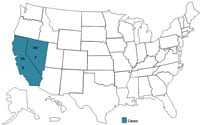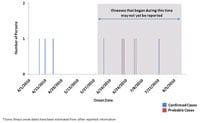News Release
Public Health Update - Salmonella Typhi (Typhoid Fever)
August 12, 2010
August 12, 2010
The Southern Nevada Health District has confirmed four cases of Salmonella Typhi, the bacterium that causes Typhoid Fever, as part of a two-state outbreak (California currently has five confirmed cases). The local patients, all of whom have recovered, are under age 30. The illness was likely contracted from consuming a frozen fruit product known as mamey fruit pulp. The situation is under investigation by the Centers for Disease Control and Prevention (CDC) and the Food and Drug Administration (FDA), working in conjunction with public health authorities from two affected states.
Currently, the health district and the CDC recommend that consumers do not eat or drink food items containing frozen Goya brand mamey fruit pulp. A voluntary product recall has been issued. Individuals who believe they might have become ill after consuming frozen mamey fruit pulp should consult their healthcare providers.
Mamey fruit pulp, sometimes called zapote or sapote, is a tropical fruit grown in Central and South America and is commonly found in markets nationwide, particularly in Hispanic communities. The product is often used in shakes and smoothies.
Typhoid Fever is a serious bacterial infection that can be treated with antibiotics. There are approximately 400 cases in the United States annually, 70 percent of which are acquired while traveling internationally. Infection occurs when a patient eats or drinks food or beverages handled by a person who is ?shedding? the Salmonella Typhi bacterium in his stool, or if sewage is contaminated with the bacterium and the water is used for drinking or washing food. The illness can last up to three or four weeks. It is recommended that people who will visit locations where Typhoid Fever is common receive the appropriate immunization from their healthcare provider or at the health district?s immunization clinic.
Symptoms occur within three days and up to three months after consuming contaminated food or water and include a sustained fever as high as 103 F to 104 F as well as stomach pains, a headache, anorexia, a slow heart rate, malaise, constipation or diarrhea, or a non-productive cough. People are the only host for the Salmonella Typhi bacterium, which is carried in the bloodstream and intestinal tract. Ten percent of untreated patients can remain infectious for as many as three months after the onset of symptoms, and 2 to 5 percent of these patients can become permanent carriers.
The Southern Nevada Health District investigates more than 100 cases of Salmonellosis annually; there have been no reported cases of Typhoid Fever, a distinct type of Salmonella infection, through 2009.
-30-
Visit the Media Contacts webpage for media related inquiries.



Comment